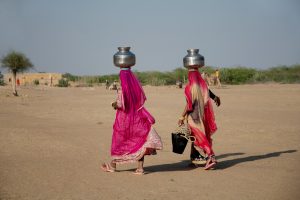Indian parliamentary elections are taking place amid soaring summer temperatures, crossing 40 degrees Celsius (104 F) as voters queue up to cast their ballots amid heat waves sweeping most parts of the country. The elections will conclude in early June and the new government will have to tackle an array of issues such as poverty, unemployment, pollution, water shortages, food insecurity, and rising temperatures that have direct linkages with climate change. In the coming months, India will also experience the annual monsoon, projected to be above average in 2024, which brings much-needed respite for the agricultural sector but also deluges parts of the country.
India’s ability to tackle climate change will depend upon domestic action and also the way it negotiates with the Global North on critical issues of climate reparations and technology transfer.
In the past few years, India, the third largest emitter of carbon dioxide behind China and the United States, has sought to position itself as the leader of the Global South in climate change negotiations. It has demanded that the world’s approach to climate change must include justice and equity accompanied by climate reparations and technology transfer.
This essentially translates to the following. First, developing countries like India will go through a measured process of energy transition while trying to balance their economic growth objectives with concerns about climate change. This is clear as India and China continue to establish coal-fired power stations, along with wind and solar power installations, even as the United States and Europe are retiring their coal plants. After all, the West’s reliance on fossil fuel for its economic growth has more than a century and half-long history, starting with the Industrial Revolution in the 1850s. China overtook the U.S. as the largest producer of CO2 in 2006. India’s avowed ambitions – including becoming a $5 trillion economy by 2028 – would be impossible to achieve without riding on energy generation using fossil fuel. While India’s economy is poised to become the third-largest by GDP in the world, mostly due to its demographics, its per capita income places it among the world’s most poverty-stricken countries.
The second argument is that the developed world, responsible for the bulk of historical emissions, must assist the developing world and the poor nations in meeting their net zero goals. According to some estimates, India will require $14-17 trillion to achieve net zero status between 2022 and 2070. This will be possible only if green climate funds, created for both climate adaptation and loss and damage, receive contributions, as per the commitments made by individual countries. Additionally, the developed world must generously pass on green technology to developing countries to expedite their energy transition. Both finances and technology are critical to achieving these goals.
While the first argument by the Global South – that their transition to green energy will be slow and time-consuming – has been broadly understood and somewhat accepted by the Global North, the second argument has seen several roadblocks. The Global North has consistently failed to stick to its commitment to contribute to reparation and technology transfer. A pledge in 2009 and reaffirmed in 2015 in Paris, to deliver $100 billion annually by 2020, through 2025, to help poorer countries recover from climate impacts remains unmet. New tensions have arisen as developing countries want a separate Loss and Damage Fund (LDF) to also receive $100 billion a year by 2030. However, the United States is not among the handful of countries that have pledged money to the fund.
Washington argues that contributions to the tenuously stitched LDF are voluntary and cannot be imposed on wealthy nations. This would mean that the Global South’s negotiations with the developed world would have to be more vigorous on specific aspects of reparation that include cash transfers, preferential financing, or other subsidies for energy transition. In the realm of technology transfer, the debate could span over issues such as suspending trade barriers to modifying intellectual property rules. The demand by the U.S. and the European Union that the list of climate financers should be expanded to include emerging economies such as China, India, and the Gulf States will also have to be negotiated.
Despite the conventional North and South paradigm that pits the developed against the developing world in climate negotiations, it is a fact that the Global South is a fractured construct consisting of economies that have wide and disparate variations. The demand for India and China’s inclusion in the LDF contributors’ list came from the Alliance of Small Island States. The Vulnerable 20 Group (V20), which has a membership of 68 developing nations, does not include China and India, lending credence to the argument that the 1992 list that distinguished the developed world from the developing world desperately needs updating.
The new government in India will have to work through the politics of climate finance, inclusion, and just transition in an increasingly fragmented world order. And this needs to be based on a scaled-up and implementable action plan to reduce carbon footprint and ramp up renewable energy, at a pace faster than it is today. India’s leadership role in bridging the climate disconnect between the Global North and Global South can be amplified by stitching together a just, inclusive, and equitable global climate order and devising innovative energy transition pathways.

































